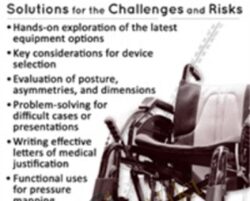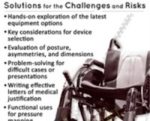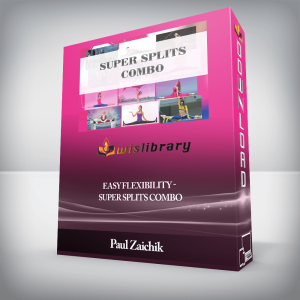Hands-on exploration of the latest equipment optionsKey considerations for device selectionEvaluation of posture, asymmetries, and dimensionsProblem-solving for difficult cases or presentationsWriting effective letters of medical justificationFunctional uses for pressure mappingCreative and cost-effective ideas for adapting poor-fitting wheelchairsThere are few courses available addressing the important topic of wheelchair seating and positioning.Get funding approval for equipment neededLearn advanced problem-solving skills for even your most challenging clientsHands-on learning opportunities with actual wheelchairs and positioning devicesLeave with new abilities to assess for client comfort and safetyEvaluate successful letters explaining medical justificationNew strategies for pressure mapping resources will be providedThis one-day course will provide you with the latest tools to increase confidence and proficiency when it comes to proper wheelchair fit, repairs, and support!OUTLINEPhysical EvaluationAbility to ambulate and perform functional ADLsAbility to transferHistory (including prior equipment and skin integrity issues)ToneAt restDuring activitySeated measurementsPosture assessment such as scoliosis, pelvic obliquityDetermining appropriate size of wheelchair and seating systemROM measurementsGoniometric measurements to validate need and necessary accommodationsMat assessment for posture/fixed deformitiesPoint of access assessmentHow the individual will drive the w/c (joystick, head control…)Ability to self-propel considerationsLightweight wheelchair and accessories to self-propelAdjustable axles to properly configure chairUtilizing Pressure MappingDocumentation purposesJustification for more expensive pressure-relieving cushion or seating systemEducational purposesPatient and family education/trainingDetermining appropriate cushionsWhere adequate pressure relief is foundEvaluating pressure relief resultsAdapting a Poorly Fitting Wheelchair: Problem-Solving SolutionsIdentification of positioning issues in existing equipmentSolutions to adapt the equipment to improve positioning and functionAnalyzing poor postures and determining causes as well as steps to rectify the issueTypes of Manual Wheelchairs and Appropriate UsersManualAdult – rigid, folding, standard, lightweightPediatric – rigid, folding, Early Intervention (strollers)Tilt in SpaceAdultPediatricSelf-propelTypes of Power WheelchairsFront wheel driveMid wheel driveRear wheel driveProgrammable electronicsScootersSeat Backs: Types and IndicationsSlingPlanarCurvedCurved with lateral supportCustom with trunk lateralsSeat Cushions: Types and IndicationsStandard or basic foamContouredPressure relievingCustom moldedHead and Cervical Supports: Types and IndicationsBasic curvedContoured with posterior and lateral supportCurrent equipment will be available to examine/trialTransportation in a Motor VehicleFrames and seating systems that have been crash testedWC19 transit approvedWriting an Effective Letter of Medical JustificationInformation that must be includedTips to streamlineLetter examples and case studiesOBJECTIVESExplain the different types of wheelchairs and who they are appropriate for.Distinguish which types of wheelchairs and seating systems insurances will fund.Determine how to measure someone for an appropriate wheelchair fit.Demonstrate how to write an effective letter of medical justification.Analyze real patient problems to guide the selection process for seating solutions.Differentiate between the various wheelchair cushions available for pressure relief purposes.Evaluate actual equipment types, wheelchairs, cushions and positioning aids.Tag: Wheelchair Seating & Mobility: Solutions for the Challenges and Risks – Diane Warns Review. Wheelchair Seating & Mobility: Solutions for the Challenges and Risks – Diane Warns download. Wheelchair Seating & Mobility: Solutions for the Challenges and Risks – Diane Warns discount.
 A Trader’s Guide to Self-Discipline – Brett Steenbarger
₹4,648.00
A Trader’s Guide to Self-Discipline – Brett Steenbarger
₹4,648.00
 Unbridle the Radiant Circuits: Aligning with the Soul’s Energy System – Sara Allen
Unbridle the Radiant Circuits: Aligning with the Soul’s Energy System – Sara Allen
Wheelchair Seating & Mobility: Solutions for the Challenges and Risks – Diane Warns
₹12,616.00






